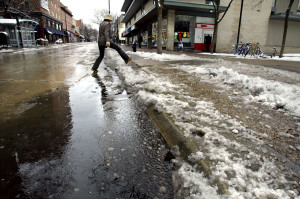
Though a slush puddle may look like a static, unchanging, boring and ugly mixture of dirty ice and water, it is actually an extremely dynamic cauldron of various phases of the magical water substance, constantly undergoing all manner of phase changes. Photo credit: Steve Apps, State Journal archives.
The recent snow and ice followed by a bit of melting filled sidewalks and some city streets with puddles of slush — that wondrous winter concoction of liquid water and ice.
Though it is not possible to see, surrounding any puddle of slush is also a cloud of countless invisible water vapor molecules. In fact, of all the many chemical constituents of the Earth’s atmosphere, only the water substance can naturally occur in all three of its phases – solid, liquid and gas – at Earth temperatures.
And, to add an even greater level of grandeur to this fact, the ice and the liquid water in the slush puddle are constantly subject to sublimation (transitioning from ice to vapor) and evaporation, respectively, while the invisible vapor is constantly liable to deposition (transitioning from vapor to ice with no intermediate liquid stage) and condensation.
So even though the slush puddle looks as if it is a static, unchanging, boring and ugly mixture of dirty ice and water, it is actually an extremely dynamic cauldron of various phases of the magical water substance, constantly undergoing all manner of phases.
These phase changes involve substantial amounts of energy transfer as well. In fact, for a gram of liquid water to evaporate to vapor, 600 calories of energy are required from the environment. When a gram of water vapor condenses, that same amount of energy is given back to the environment.
A scientist’s view of the world need be no less lyrical than a poet’s — we hope you will never see slush puddles the same again.

